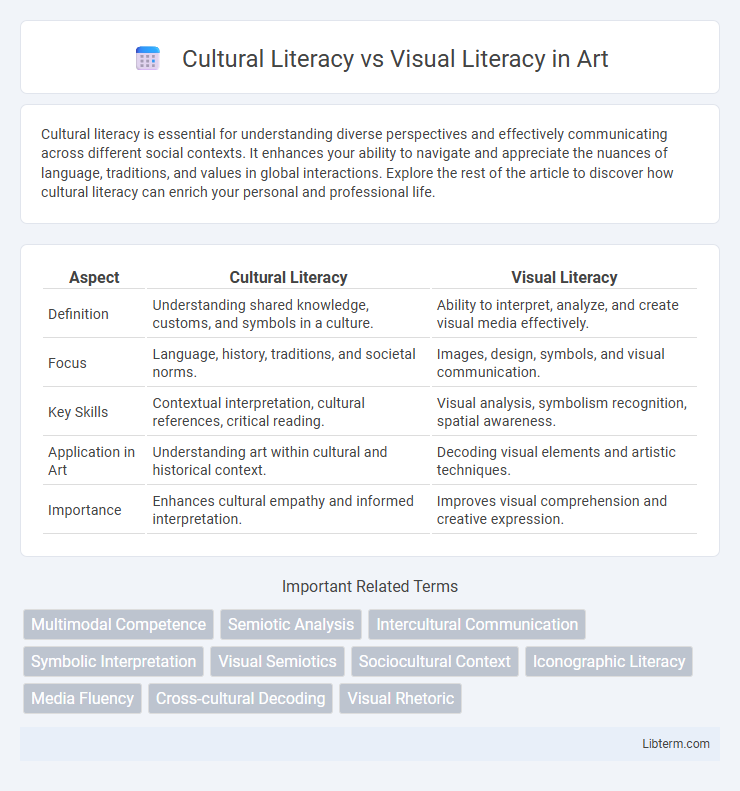Cultural literacy is essential for understanding diverse perspectives and effectively communicating across different social contexts. It enhances your ability to navigate and appreciate the nuances of language, traditions, and values in global interactions. Explore the rest of the article to discover how cultural literacy can enrich your personal and professional life.
Table of Comparison
| Aspect | Cultural Literacy | Visual Literacy |
|---|---|---|
| Definition | Understanding shared knowledge, customs, and symbols in a culture. | Ability to interpret, analyze, and create visual media effectively. |
| Focus | Language, history, traditions, and societal norms. | Images, design, symbols, and visual communication. |
| Key Skills | Contextual interpretation, cultural references, critical reading. | Visual analysis, symbolism recognition, spatial awareness. |
| Application in Art | Understanding art within cultural and historical context. | Decoding visual elements and artistic techniques. |
| Importance | Enhances cultural empathy and informed interpretation. | Improves visual comprehension and creative expression. |
Understanding Cultural Literacy: Definition and Scope
Cultural literacy encompasses the ability to understand and participate fluently in a given culture by recognizing its symbols, values, customs, and historical references. It involves knowledge of language nuances, social norms, literature, arts, and shared traditions that enable effective communication within a culture. This literacy extends beyond basic facts, requiring context awareness and interpretive skills to navigate and contribute meaningfully to cultural conversations and practices.
What is Visual Literacy? Key Concepts Explained
Visual literacy refers to the ability to interpret, negotiate, and make meaning from information presented in the form of images, symbols, and visual data. Key concepts include understanding visual elements such as color, composition, symbolism, and context to decode messages effectively. Mastery of visual literacy enables individuals to critically analyze media, advertisements, and artistic works beyond surface-level interpretations.
Historical Evolution of Cultural and Visual Literacy
Cultural literacy emerged as a concept in the mid-20th century, emphasizing knowledge of historical events, literature, and social norms to foster effective communication and shared understanding within societies. Visual literacy developed later, gaining prominence in the digital age with the rise of images and multimedia, focusing on the ability to interpret, analyze, and create meaning from visual information. Both literacies have evolved to address changing modes of communication, with cultural literacy rooted in textual and contextual knowledge and visual literacy centered on decoding visual symbols and narratives in contemporary media.
The Role of Culture in Shaping Perceptions
Culture fundamentally shapes perceptions by providing a framework through which individuals interpret symbols, images, and visual cues. Cultural literacy enables people to understand embedded meanings within visual content, while visual literacy develops the ability to decode and critically analyze these images across diverse cultural contexts. Differences in cultural backgrounds influence how visual messages are perceived, making cultural awareness essential for accurate interpretation and communication.
Visual Literacy in the Digital Age
Visual literacy in the digital age encompasses the ability to interpret, analyze, and create visual content across diverse digital platforms, including social media, websites, and multimedia applications. Mastery of visual literacy enables individuals to critically evaluate images, videos, and graphic elements, recognizing underlying messages, biases, and cultural contexts embedded within digital media. Enhanced visual literacy skills are crucial for navigating the overload of information in digital environments, empowering users to communicate effectively and engage meaningfully in an increasingly image-driven society.
Comparing the Impact of Cultural and Visual Literacy
Cultural literacy equips individuals with an understanding of shared knowledge, historical context, and societal norms, enabling effective communication and interpretation within diverse cultural frameworks. Visual literacy enhances the ability to decode and create meaning from images, symbols, and visual media, critical in an increasingly digital and image-driven world. Both literacies influence cognition and communication, with cultural literacy fostering contextual comprehension and visual literacy advancing interpretative skills, together shaping more nuanced perception and interaction in complex social environments.
Interconnectedness: Cultural Contexts in Visual Communication
Visual communication is deeply influenced by cultural literacy, as understanding the cultural contexts behind symbols, colors, and imagery enhances interpretation and meaning. Visual literacy requires recognizing how cultural values and historical backgrounds shape visual narratives across different societies. Interconnectedness between cultural literacy and visual literacy ensures effective communication by aligning visual messages with the audience's cultural frameworks.
Challenges in Achieving Cultural and Visual Literacy
Challenges in achieving cultural literacy include navigating diverse cultural backgrounds, overcoming language barriers, and addressing implicit biases that hinder understanding of global perspectives. Visual literacy faces difficulties such as interpreting complex images without context, varying symbolic meanings across cultures, and the rapid evolution of digital media that demands continuous adaptation. Both literacies require critical thinking and exposure to multifaceted content to develop comprehensive interpretive skills.
Educational Strategies for Enhancing Both Literacies
Educational strategies for enhancing cultural literacy and visual literacy include integrating multimedia resources and diverse cultural narratives into the curriculum to foster critical thinking and contextual understanding. Project-based learning that combines analysis of cultural artifacts and visual media encourages students to navigate symbolism, context, and meaning effectively. Collaborative workshops and interdisciplinary approaches involving literature, history, and art equip learners with the skills to interpret both verbal and visual information in varied cultural frameworks.
The Future of Literacy: Integrating Cultural and Visual Skills
The future of literacy demands an integrated approach that combines cultural literacy--understanding diverse cultural contexts and symbols--with visual literacy, the ability to interpret and create meaning from images and visual media. As digital communication increasingly relies on multimedia formats, fluency in both cultural nuances and visual interpretation becomes essential for effective communication and critical thinking. Educators and technology developers must collaborate to design curricula and tools that enhance these intersecting literacies, preparing individuals for a more interconnected, image-centric world.
Cultural Literacy Infographic

 libterm.com
libterm.com